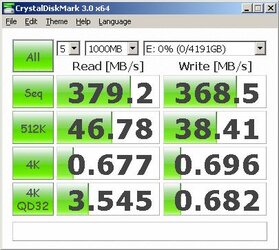Seagate Baracuda 1.5TB *2 in RAID 0 on X58 board using intel matrix raid. (primary OS drive, single large partition)
-----------------------------------------------------------------------
CrystalDiskMark 3.0 x64 (C) 2007-2010 hiyohiyo
Crystal Dew World : http://crystalmark.info/
-----------------------------------------------------------------------
* MB/s = 1,000,000 byte/s [SATA/300 = 300,000,000 byte/s]
Sequential Read : 154.361 MB/s
Sequential Write : 141.203 MB/s
Random Read 512KB : 30.551 MB/s
Random Write 512KB : 27.744 MB/s
Random Read 4KB (QD=1) : 0.369 MB/s [ 90.1 IOPS]
Random Write 4KB (QD=1) : 1.286 MB/s [ 313.9 IOPS]
Random Read 4KB (QD=32) : 1.140 MB/s [ 278.3 IOPS]
Random Write 4KB (QD=32) : 1.345 MB/s [ 328.3 IOPS]
Test : 1000 MB [C: 94.3% (1317.8/1397.3 GB)] (x5)
Date : 2010/08/28 9:18:38
OS : Windows Vista Ultimate Edition [6.0 Build 6000] (x64)
same model drives as before (barracuda 1.5TB) but in RAID 1 gigabyte mirror. 120gig partitition, primary boot drive.
-----------------------------------------------------------------------
CrystalDiskMark 3.0 (C) 2007-2010 hiyohiyo
Crystal Dew World : http://crystalmark.info/
-----------------------------------------------------------------------
* MB/s = 1,000,000 byte/s [SATA/300 = 300,000,000 byte/s]
Sequential Read : 127.054 MB/s
Sequential Write : 73.348 MB/s
Random Read 512KB : 44.072 MB/s
Random Write 512KB : 48.812 MB/s
Random Read 4KB (QD=1) : 0.626 MB/s [ 152.8 IOPS]
Random Write 4KB (QD=1) : 1.287 MB/s [ 314.3 IOPS]
Random Read 4KB (QD=32) : 0.657 MB/s [ 160.5 IOPS]
Random Write 4KB (QD=32) : 1.354 MB/s [ 330.5 IOPS]
Test : 1000 MB [C: 8.3% (9.3/112.3 GB)] (x5)
Date : 2010/08/27 23:48:29
OS : Windows Server 2003 Enterprise Edition SP2 [5.2 Build 3790] (x86)
Remaining partition of the drives above, well now I know why I was having speed issues from this server now.
-----------------------------------------------------------------------
CrystalDiskMark 3.0 (C) 2007-2010 hiyohiyo
Crystal Dew World : http://crystalmark.info/
-----------------------------------------------------------------------
* MB/s = 1,000,000 byte/s [SATA/300 = 300,000,000 byte/s]
Sequential Read : 87.865 MB/s
Sequential Write : 70.055 MB/s
Random Read 512KB : 28.952 MB/s
Random Write 512KB : 42.996 MB/s
Random Read 4KB (QD=1) : 0.343 MB/s [ 83.7 IOPS]
Random Write 4KB (QD=1) : 0.790 MB/s [ 192.9 IOPS]
Random Read 4KB (QD=32) : 0.579 MB/s [ 141.4 IOPS]
Random Write 4KB (QD=32) : 0.854 MB/s [ 208.4 IOPS]
Test : 1000 MB [E: 87.5% (1124.1/1284.9 GB)] (x5)
Date : 2010/08/27 23:58:02
OS : Windows Server 2003 Enterprise Edition SP2 [5.2 Build 3790] (x86)


